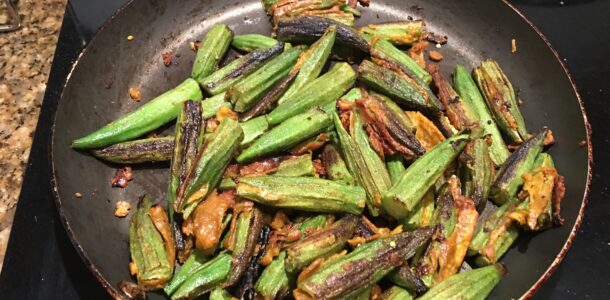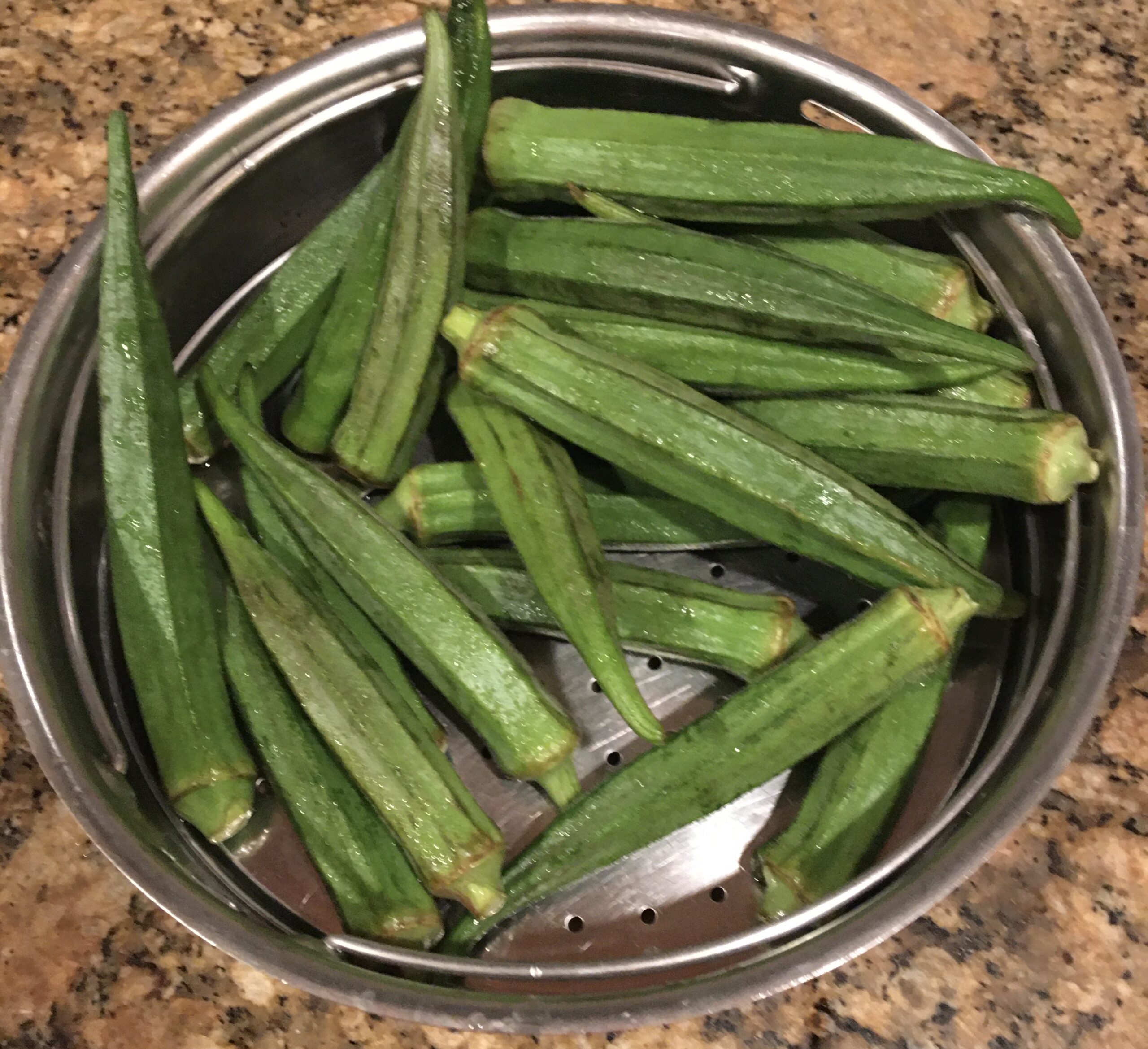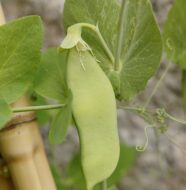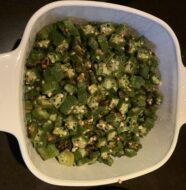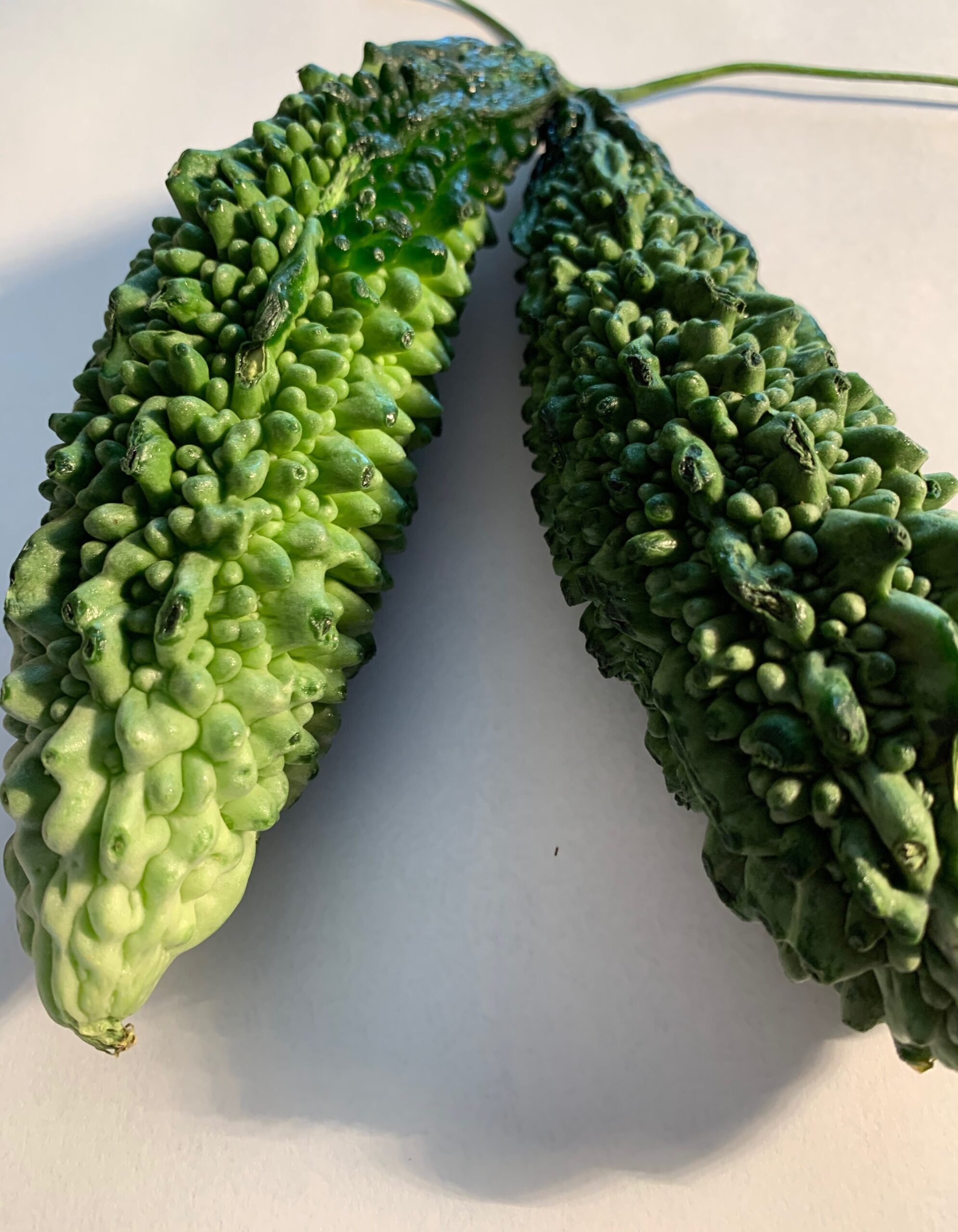Okra, known as Lady’s fingers or Bamia / Gumbo in Swahili was introduced to America by Ethiopian slaves and widely used in Indian cuisine. It is a member of the mallow family, its scientific name is Abelmoschus esculentus. The green okra pods have a ridged skin and a tapered, oblong shape. They are available fresh, year-round in the southern states of the U.S.A. Okra can be pickled, frozen, canned., dehydrated, and sun-dried. Okra is being cooked in many countries of the world from the Caribbean to Africa to China and becoming more popular
Buying Okra and storage: When buying okra look for firm, brightly colored pods under 4″ long. Larger pods may be tough and fibrous. Avoid picking those that are dull in color, limp or blemished. Refrigerate okra in a plastic bag for up to 3 days. Do not wash okra until ready to cook. If you are not going to use okra for a few days freeze them after blanching in boiling water for 3-4 min. and immersed in an ice bath for 5 min. Then freeze in freezer bags expelling all air from it.
History: Okra, known scientifically as “Abelmoschus esculentus or Hibiscus esculentus” derived its name from the Niger-Congo region in Africa. It is a member of the mallow family related to cotton, hibiscus, and hollyhock. It originated in Ethiopia and cultivated by ancient Egyptians by the 12th century. Its cultivation spread to North Africa and the Middle East. Okra came to the Caribbean in the 1700s probably brought by slaves from West Africa. and Introduced to Western Europe soon after. In Louisiana, the creoles learned from the slaves the use of okra to thicken soups and it is now essential in the stew “Creole Gumbo”.
Okra Dishes
Okra can be prepared in many ways: braising, baking, breading & frying. In Indian style of making okra is sautéed, stuffed, cooked in tamarind sauce mixed with yogurt as a salad. It can also be pickled, dehydrated, sundried & preserved for use during the rainy season like sundried tomatoes.
Okra Yogurt Salad (Bhendi Raitha)
Okra in Tamarind Sauce (Vendaikai Sambhar)
Okra Sauté (Vendaikai Porial )
Stuffed Okra (Bhara Bhendi)
Sun dried Okra (Vendaikai Vatral)
Nutrition facts of Okra
| GI = 20; GL = 2 Water =92.6 g |
Minerals | Vitamins |
| Energy 33cal -1.5% | Sodium 8 mg – 0.5% | Folates 88mcg – 22% |
| Carb. 7.03g – 5.4% | Potassium 303mg – 6% | Niacin 1.0 mg – 6% |
| Protein 2.0g – 4% | Calium 81 mg – 8% | pantothenic acid 0.245mg – 5% |
| Total Fat 0.1g – 0.5% | Copper 0.094mg – 10% | Pyridoxine 0.215mg – 16.5% |
| Cholesterol 0 mg – 0% | Iron 0.80mg -10% | Riboflavin 0.06mg – 4.5% |
| Dietary Fiber 3.2g – 9% | Magnesium 57mg – 14% | Thiamin 0.20 mg – 17% |
| Sugar 1.5g | Manganese 0.990mg – 43% | Vitamin C 21.1 mg – 36% |
| Carotene Beta 225 mug | Phosphorous 63mg – 9% | Vitamin A 375 IU – 12.5 % |
| Lutein zea xanthin 516 mug | Selenium 0.7 mug – 1% | Vitamin E 0.36mg – 2.5% |
| Zinc 0.6 mg – 5.5 % | Vitamin K 53mug – 44% |
Health Benefits of Okra
- Okra has the ability to lower total cholesterol levels.
- Okra improves digestion with Mucilaginous fiber by adding bulk.
- Okra protects eyes against Macular degeneration and cataracts.
- Okra promotes quicker healing, reduces wrinkle formation, scars & acne.
- Okra prevents cancer: certain types.
- Okra lowers blood pressure and protects heart health
- Okra strengthens bones and boosts the immune system
- Okra recommended as part of a weight loss program
- Okra can stabilize blood sugar levels; research in okra’s potential to manage diabetes is ongoing
Spice Power
- Peanut powder: a rich source of protein.100g contains 25-30g. Proteins are broken down into amino acids which are utilized in every cell in repairing and building the body.
- Coconut flakes: good source of iron that prevents symptoms of anemia. 1/2 cup provides 11% of RDA. iron helps oxygenate your blood and bring it to all parts of the body-boosting energy levels and building healthy muscles.
- Turmeric powder: the anti-inflammatory and soothing nature of this herb’s natural compounds can relieve most of the symptoms of menstruation like cramping, bloating, excessive bleeding and mood swings,
- Red chili powder: promotes weight loss – Capsaicin in it is thermogenic. It increases cravings and increases metabolism. The heat felt after consuming chili pepper already takes energy and burns calories. Even cosmetic manufacturers have incorporated chili peppers in slimming lotions.
- Coriander powder: is a powerful colon cleansing agent.its unique aroma and health properties come from its volatile oils like linalool, a-pinene, geraniol, camphene, and terpene; and fatty acids like Petroselinic acid, Linoleic acid (omega 6), Oleic, and Palmitic acid. They give the powder their digestive, carminative, and anti flatulence characteristics.
- Cumin powder: lowers cholesterol with its hyperlipidemic properties and aids in weight reduction.
- Mango powder: reduces acidity, improves digestion, and enhances bowel movements. They contain Phenols that are powerful antioxidants with anti-cancer properties. They address the maladies of pregnant women namely indigestion, acidity, and constipation.
Method to cook stuffed Okra (Bhara Bhendi)
Some recent studies have suggested that okra may help lower blood sugar levels by reducing the rate at which intestines absorb glucose. This gourmet dish is a delicacy added to buffet lunches or dinners. In this North Indian style preparation, okra is stuffed with gram flour, peanut powder & spices; cooked in its own moisture, and sauteed in oil.
To make stuffing:
- Mix gram flour, peanut powder, coconut flakes & spices; add water to make a paste.
- Wash and wipe okra; slit whole okra lengthwise without cutting through.
- Its two sides should be able to open like a book.
- Insert filling through slits and press down. (5 min.)
- Place Okras in a microwave-safe container.
- Drizzle with vinegar or buttermilk and cook in a microwave. ( 8 min.)
- Sautéing:
- Heat the oil in a nonstick frying pan.
- Add okras and sauté on medium heat, until light brown. ( 7 min.)
- Baking :
- Place stuffed okras in a casserole pan, cover with foil and bake 20 min at 350F
Serve Bhara Bhendi with Quinoa, Coconut Rice, Bread Rolls, Pasta or Chapatis.
TIPS
Buttermilk prevents okras from sticking together
Stuffed okras can be cooked directly in a wok on a stove
This would need constant stirring of okra to ensure even cooking
references
https://facty.com/food/nutrition/10-amazing-benefi
https://www.organicfacts.net/coconut-meat.html
https://www.organicfacts.net/health-benefits/herbs.
https://www.naturalfoodseries.com/chili-pepper-hea…https://www.speakingtree.in/allslides/coriander-po…
https://www.organicfacts.net/health-benefits/seed-…
https://timesofindia.indiatimes.com/life-style/hea….

